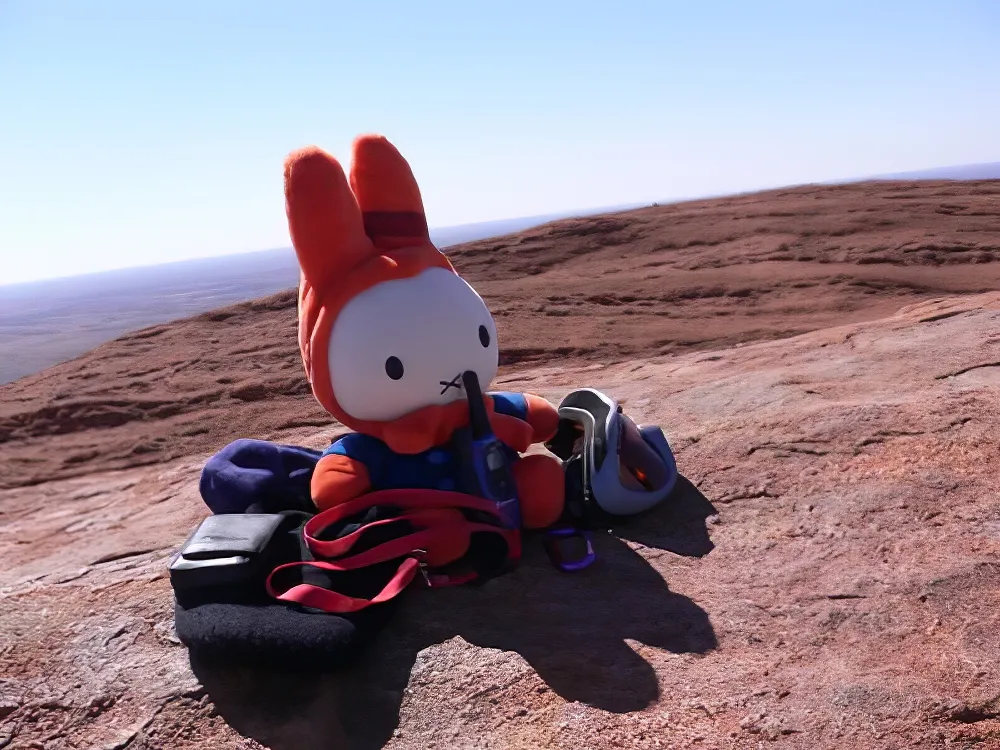
Outback and The Red Center is Australia’s old wild territory .The desert, Roadtrains, wild animals and extreme temperatures and conditions are present in this remote part of the country.
Here, in this remote part Uluru (Ayers Rock) stands up. An aboriginal sacred site who Miffa climbed up setting another bunny world record.
This post notes and thoughts in 2023
We received some negative feedback about climbing Uluru / Ayers Rock and even more criticism for the picture. The fact is that back in 2006 climbing was legal and there were few sign asking for taking into consideration anangu people desires.
Honestly we did not see them, it was early in the morning and we were until very late on the previous night and the whole thing was improvised. Part of our team remained in the caravan and only three people plus Miffa ascended faster as possible.
Climbing Uluru Controversial Activity Through Time
Uluru, also known as Ayers Rock, is a large sandstone rock formation in central Australia. This stunning natural landmark is considered sacred by the local Anangu people, who have lived in the area for thousands of years. Over the years, climbing Uluru has become a popular tourist activity, but it is also a controversial one.
History of Climbing Uluru
The first recorded ascent of Uluru was in 1873 by a surveyor named William Gosse. Gosse named the rock Ayers Rock after the then-Chief Secretary of South Australia, Sir Henry Ayers.
Climbing Uluru became a popular activity among visitors to the area in the 1930s. In 1948, the first recorded climbing death occurred when a man fell from the rock. Despite this tragedy, climbing Uluru continued to be a popular activity.
Arguments for and Against Climbing Uluru
The Anangu people have always asked visitors not to climb Uluru because of its spiritual significance. They see it as a sacred site that should be respected and protected.
The Anangu also believe that the act of climbing Uluru is disrespectful to their ancestors, who they believe reside in the rock. The Anangu people request that visitors observe their wishes and not climb the rock.
On the other hand, climbing Uluru is an important tourist activity that provides economic benefits to the region. Some argue that the money generated from tourism is important for the local economy and that the activity should be allowed to continue. Money, always money…
Miffa Chan’s second visit to Uluru / Ayers Rock
In our second visit. with CafeMiffy friends ir was still legal to climb Uluru but we decided not to do it to respect Anangu people desire. We made a light walk around the rock (around 11 kilometers) and wait to sunset to take pictures.
Current Status of Climbing Uluru
In November 2017, the Anangu people’s wishes were finally respected when it was announced that climbing Uluru would be banned from October 2019. The decision was made after many years of consultation and discussion between the Anangu people, the tourism industry, and the government. The decision to ban climbing Uluru was made by the Uluru-Kata Tjuta National Park Board, which is responsible for managing the park.
Since the ban has been put in place, the number of visitors to Uluru has not decreased.

even, when you do extreme performances, you look so fresh.
Your hair band,your serene attitude.
You’re the best bunny ever!
even, when you do extreme performances, you look so fresh.Your hair band,your serene attitude.You’re the best bunny ever!
even, when you do extreme performances, you look so fresh.
Your hair band,your serene attitude.
You’re the best bunny ever!